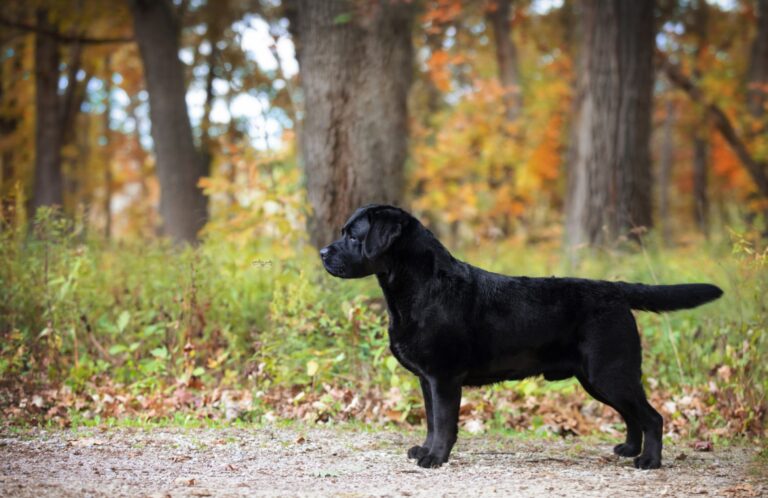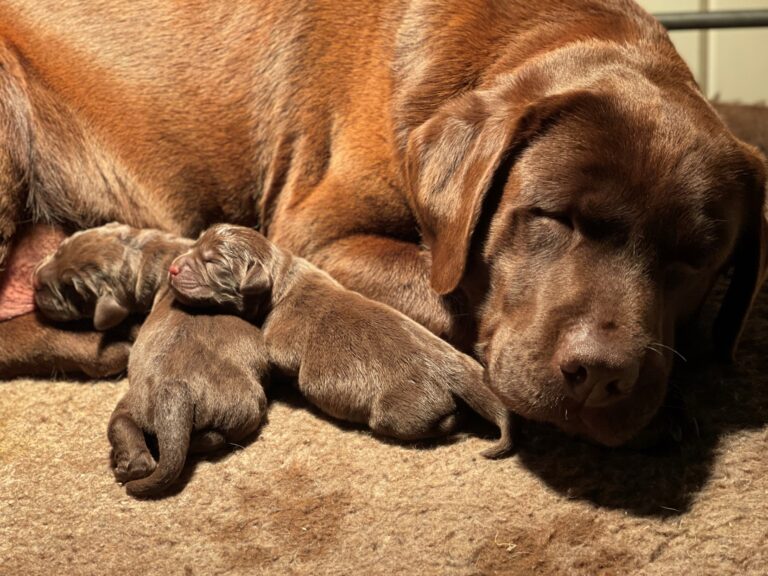Breed standard
LABRADOR RETRIEVER
Origin: Great Britain
UTILIZATION:
Retriever – Companion dog
GENERAL ASPECT:
Strongly built, short-coupled, very active; (which precludes excessive body weight or substance) broad in skull; broad and deep through chest and ribs; broad and strong over loins and hindquarters.
FEATURES:
This dog has a good temperament and is very agile. It has an excellent sense of smell and a delicate muzzle with a soft mouth; it is very fond of water. It is an adaptable, faithful and devoted companion.
TEMPERAMENT:
Good-tempered, very agile. Excellent nose, soft mouth; keen lover of water. Adaptable, devoted companion. Intelligent, keen and biddable, with a strong will to please. Kindly nature, with no trace of aggression or undue shyness.
HEAD AND CRANIUM:
CRANIAL REGION: Skull: Broad. Clean-cut without fleshy cheeks. Stop: Defined. FACIAL REGION: Nose: Wide, nostrils well developed. Muzzle: Powerful, not snipy. Jaws / Teeth: Jaws of medium length, jaws and teeth strong with a perfect, regular and complete scissor bite, i.e. upper teeth closely overlapping lower teeth and set square to the jaws.
EYES:
Medium size, expressing intelligence and good temper; brown or hazel.
EARS:
Not large or heavy, hanging close to head and set rather far back.
SNOUT:
Strong jaws and teeth, with healthy, complete dentition, and scissor bite, i.e. the inner face of the upper incisors in contact with the outer face of the lower incisors, and well positioned in the jaws.
NECK:
Clean, strong, powerful, set into well placed shoulders.
FORELIMB:
The scapulae are long and sloping. Limbs of good bone and, when viewed from the front or side, should appear straight from the elbows to the ground.
BODY:
Topline: Level. Loin: Wide, short-coupled and strong. Chest: Of good width and depth, with well sprung barrel ribs – this effect not to be produced by carrying excessive weight.
HIND LIMBS:
Well developed and without inclination towards the tail; the femoro-tibio-rotulian joints (knees) well angulated. Hocks let down, hocks together are highly undesirable.
FEET:
Feet round, compact, with well arched toes and well developed plantar pads.
TAIL:
Distinctive feature, very thick towards base, gradually tapering towards tip, medium length, free from feathering, but clothed thickly all round with short, thick, dense coat, thus giving “rounded” appearance described as “Otter” tail. May be carried gaily, but should not curl over back.
MOVEMENT:
Free, covering adequate ground; straight and true in front and rear.
HAIR:
Distinctive feature, short, dense, without wave or feathering, giving fairly hard feel to the touch; weather-resistant undercoat.
COLOUR:
Wholly black, yellow or liver/chocolate. Yellows range from light cream to red fox. Small white spot on chest permissible.
SIZE:
Ideal height at withers: Males: 56-57 cm (22-22 1/2 inches).
Females: 54-56 cm (21 1/2 inches).
DEFECTS:
Any departure from the foregoing points should be considered a fault and the seriousness with which the fault should be regarded should be in exact proportion to its degree and its effect upon the health and welfare of the dog and on its ability to perform its traditional work.
NOTE:
Male animals should have two apparently normal testicles fully descended into the scrotum.

Care
Most frequent pathologies in the Labrador Retriever
(summary extracted from our breed club's website www.aelr.es )
Despite what it may seem, the Labrador Retriever is one of the healthiest, most athletic and healthy breeds; all the diseases listed below occur in many other breeds, but perhaps the success in breeding Labradors in Great Britain and the USA, where they are one of the most popular breeds, means that we have a greater knowledge of the diseases they can suffer from, which does not mean that they are more frequent in this breed.
HIP DYSPLASIA
Hip dysplasia is the hereditary disease most known by owners, breeders and veterinarians, affecting a large number of medium and large breeds mainly. Affected animals present an abnormal development of the coxofemoral joint, with an inadequate coaptation between the femoral head and the acetabulum, causing a premature wear of the articular cartilages, this defect in the conformation triggers arthritic changes that cause the symptomatic picture of the disease.
The etiology of the disease is multifactorial polygenic, there are several genes that will determine the structure of the hip (genotype), but these genes will be expressed to a greater or lesser extent depending on the influence of the environment (food, exercise, habitat, etc.), from the interaction of these two factors (genotype and environment), we will obtain as a result a specific type of hip (phenotype).
At birth all puppies have healthy hips, and it is during the growth phase when the animal predisposed to dysplasia, because it is written in its genetic code, will develop the disease to a greater or lesser degree depending on environmental conditions. The most critical phase of growth is from 3 months to 8 months, although it has been proven that obesity in puppies as young as 2 months can be almost determinant for the onset of the disease. In this short period of time we should take maximum care of environmental factors, for example, nutrition and exercise.
La nutrición es el factor más importante. Deberán evitarse dietas hipercalóricas que producirán perros con sobrepeso, este exceso de peso acentúa las sobrecargas en la articulación causando mayor desgaste de los cartílagos articulares y por tanto originando con mayor rapidez cambios artrósicos. Asimismo, se deben evitar también las dietas hiperproteicas, que van a producir unos altos índices de crecimiento que darán lugar a descompensaciones entre la formación de tejido óseo y el tejido muscular.
As for exercise, it should be moderate until the first year of age, we should avoid long walks; they are perhaps the least recommended exercise, since little muscle mass is created, and yet it involves a great joint wear. Swimming is the most adequate and complete method, since it produces a muscular hypertrophy without forcing the articulation at all, since the dog does not exert loads or pressures on the extremities at any time.
ELBOW DYSPLASIA
As in the case of the hip, this is a genetically based disease in which abnormalities occur during the puppy's development that affect the elbow joint, although this name encompasses two different pathological entities:
- Non-union of the anconic process
- Coronoid process fragmentation.
Both pathologies are primary lesions that stabilize around one year of age, giving way secondarily to the appearance of osteoarthrosis processes in the elbow joint.
The genetic cause and environmental factors are the same as for hip dysplasia; consequently, the methods for eradication and control of the disease will also be the same.
ANTERIOR CRUCIATE LIGAMENT RUPTURE
There is no genetic basis for this pathology, but there is a predisposition of the breed due to its conformation. The knee joint is not very well constructed and relies on a large number of ligaments and cartilage to keep it stable. This joint is used both in jumping and in propulsion, and given the weight and morphology of the Labrador, the biomechanical loads on the knees can be excessive in a jump with displacement or in a running turn with too much inertia, in which case it is the anterior cruciate ligament that ruptures causing a sudden onset lameness. For its diagnosis, X-rays of the affected joint are taken and the drawer test is performed, in which the excessive displacement of the femur on the tibia is seen due to the lack of ligamentous support. Surgical repair is the treatment that gives the best results.
GENETIC DISEASES
Thanks to the large number of existing breeds, today we have a wide variety of genetic tests to control many diseases that affect Labrador Retrievers and other breeds of dogs.
Among them, the most frequent are progressive retinal atrophy (PRA), exercise-induced collapse (EIC) and nasal hyperkeratosis (HNPK) in addition to degenerative myelopathy (DM) and others of lower incidence but which we also test in our specimens.
In this type of disease, we can control that the puppies are always healthy, and it is our duty as responsible breeders to ensure that this is the case.

Responsible breeding
Although there is room for a great number of definitions in this concept, dog breeding is a very complex task that must be carried out out out of true passion as a fundamental motive, with criteria and training and always under veterinary supervision.
The objective that we must all have in common is the respect and passion for our dogs, seeking in each of our litters an improvement of the breed, preserving their morphological qualities and temperament and preserving the health of both our dogs and our puppies.
For this, at Del Trango our dogs live with us, at home, in a 30,000 m2 farm where they can enjoy and exercise properly.
In addition, we all enjoy our walks on the beach or in the mountains, and we also work on their socialization in the city from an early age.
Our puppies grow and develop in family, making the most of their mother's education and coexistence with their siblings for their correct development, and that is why we never give them to their new families before they are 9 weeks old.
In this way, they also comply with their vaccination and deworming schedule, and are correctly identified with their microchip and passport.
All our breeders, males and females, have been selected not only for their beauty and temperament, but also by passing their health tests for hip and elbow dysplasia and obtaining their corresponding official certificates. In addition, the genetic tests for common diseases in the breed, which we test in all of them, allow us to certify that the puppies will never suffer from them.
But in order to truly assess the conditions and quality of life of all of them, it is best to do it at home. We invite you to come and meet us!

